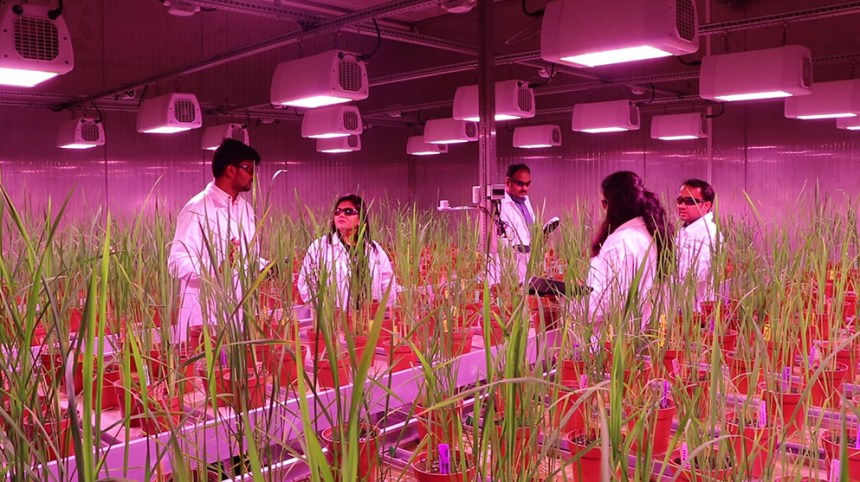As the global population nears 9.9 billion by 2050, securing an adequate food supply is becoming an increasingly pressing challenge. Addressing this challenge requires innovative approaches to plant breeding that can deliver improved crop varieties more efficiently. One such transformative approach is speed breeding (SB), a suite of techniques designed to drastically reduce crop generation times. This article explores the revolutionary potential of speed breeding, its current applications, and how it could reshape modern agriculture.
The Limitations of Traditional Plant Breeding
Traditional plant breeding is a complex and time-consuming process. It typically involves multiple steps: growing plants, selecting the best individuals, crossing them to create new generations, and evaluating these generations for desirable traits. This process can span several months to years, depending on the crop species and environmental conditions, which can impede the rapid development of new cultivars. To mitigate these limitations, researchers have sought methods to accelerate plant breeding. Speed breeding represents a groundbreaking approach that leverages controlled-environment (CE) conditions and specific interventions to enhance the rate of plant improvement. By compressing the time required for each generation, speed breeding holds the promise of significantly boosting the efficiency of crop development.
What is Speed Breeding?
Speed breeding encompasses a range of techniques designed to shorten the plant lifecycle and enhance breeding efficiency. These techniques rely on manipulating environmental factors such as light, temperature, and growth conditions to expedite plant growth and development. Key methodologies include:
- Accelerated Single-Seed Descent (aSSD): This technique involves the rapid development of homozygous lines from a single seed, thus expediting the creation of stable plant varieties. By reducing the time needed to achieve genetic uniformity, aSSD accelerates the breeding process.
- Rapid Generation Cycling (RGC): RGC utilizes DNA marker technology to enable more breeding cycles per year. This approach facilitates faster evaluation and selection of desirable traits, accelerating the overall breeding process.
- Fast Generation Cycling (FGC): By growing plants under controlled stress conditions and using in vitro culture techniques, FGC enables the production of more generations per year. This method is particularly useful for species that require a shorter growth cycle.
- Rapid Generation Turnover (RGT): RGT focuses on increasing the number of generations per year through early seed harvest and manipulation of photoperiod responses. This technique accelerates the development of new cultivars by shortening the time to flowering and seed maturity.
These methods make use of advanced controlled-environment agriculture techniques, such as artificial lighting and precise temperature control. For example, photoperiod extension, which involves adjusting light duration, can significantly reduce the time to flowering and seed maturity.
Recent Advancements and Success Stories
Speed breeding has demonstrated impressive results across a range of crop species and breeding programs. Recent advancements highlight the versatility and impact of this approach:
Wheat: In a groundbreaking study conducted at the University of Queensland, speed breeding techniques were used to develop wheat varieties with improved disease resistance and yield potential. By utilizing extended photoperiods and controlled-environment conditions, researchers were able to advance multiple generations within a single year, significantly accelerating the development of new wheat varieties.
Barley
Speed breeding has proven effective in barley as well. Researchers at the International Center for Agricultural Research in the Dry Areas (ICARDA) applied SB techniques to analyze multiple disease-resistance traits in European two-rowed barley. The rapid generation turnover enabled by SB facilitated the identification and development of barley varieties with enhanced resistance to fungal diseases.
Chickpea
The integration of speed breeding with marker-assisted selection (MAS) has accelerated the development of herbicide-tolerant chickpea varieties. A recent study led by the International Crops Research Institute for the Semi-Arid Tropics (ICRISAT) used SB techniques to shorten the breeding cycle and accelerate the introgression of herbicide tolerance traits, leading to the rapid release of new chickpea varieties.
Lentil
In lentil breeding, speed breeding has been employed to introgress valuable allelic variations from wild lentil relatives. Researchers at the Indian Agricultural Research Institute (IARI) used SB techniques to expedite the development of lentil varieties with enhanced genetic diversity and resilience. This approach has led to the rapid development of lentil cultivars with improved drought tolerance and disease resistance.
Canola
A recent study in Australia used speed breeding to develop new canola varieties with improved oil quality and disease resistance. By leveraging advanced lighting systems and controlled-environment conditions, researchers were able to achieve rapid generation turnover, resulting in the development of high-yielding canola varieties with enhanced traits.
Overcoming Challenges and Future Prospects
While speed breeding offers substantial benefits, it also faces several challenges. One major obstacle is the need for further optimization of SB protocols for different crops and growing conditions. For instance, while SB techniques have been extensively applied to long-day plants, their application to short-day plants is still evolving.
Additionally, the cost of implementing advanced controlled-environment systems and artificial lighting can be prohibitive for some breeding programs. However, recent advancements in low-cost growth room designs and flexible SB protocols are helping to address these challenges and make speed breeding more accessible.Looking ahead, the integration of speed breeding with emerging technologies such as genomic selection and gene editing presents exciting opportunities for further accelerating crop improvement. Combining SB with these advanced techniques can lead to even faster genetic gains and the development of crops better suited to future environmental conditions.
Speed breeding represents a transformative shift in plant breeding, offering a powerful tool for accelerating crop improvement and addressing the challenges of feeding a growing global population. By reducing the time required to advance crop generations and integrating SB with other modern techniques, researchers can achieve significant advancements in crop performance and sustainability.The success stories of speed breeding in wheat, barley, chickpea, lentil, and canola highlight its potential to revolutionize modern agriculture.
As speed breeding continues to evolve and overcome existing challenges, it holds the promise of playing a pivotal role in shaping the future of agriculture and ensuring food security for generations to come. With ongoing research and development, speed breeding is set to become a cornerstone of modern plant breeding, driving innovation and efficiency in the quest to develop the next generation of high-performing crop varieties. The future of agriculture looks promising, with speed breeding leading the way in advancing crop improvement and enhancing global food security.
(Author is scientist at MRCFC-Khudwani, SKUAST Kashmir and also Visiting Scientist, University of Nebraska Lincon, USA. Feedback: drahmadm786@rediffmail. And [email protected])








